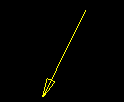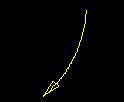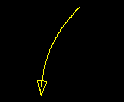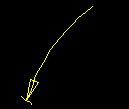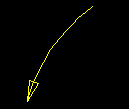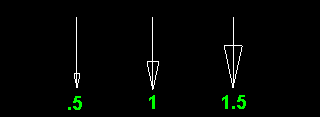The Pointer Edit window ( Drawing Editor )
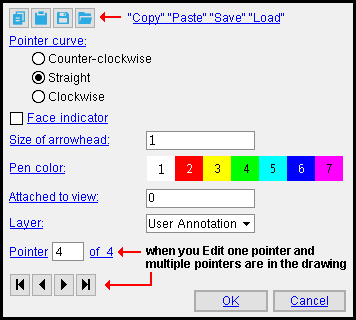
To set the defaults for Pointer Add , double-click a pointer to open this window, then press " OK ." The default settings for the new pointer will be the pointer you double-clicked.
Also see :
- Pointers (topic)
- Grayed out fields (indicate mixed entries or that the field is disabled)
- Multi Items Edit (related window)
page 1 | contents | objects > pointers > | objects -- pointers | top
 " Copy " " Paste " " Save " " Load " buttons:
" Copy " " Paste " " Save " " Load " buttons:
page 1 | contents | objects > pointers > | objects -- pointers | top
------ Settings ------
Pointer curve: Straight or Clockwise or Counter-clockwise . This sets the curvature the pointer.
|
|||||
| Tip: Hold down the Shift key and drag the middle of the pointer in Select Items mode to straighten the pointer or change its curvature . |
Face indicator: ![]() or
or ![]() . The face indicator is a wavy line drawn under the tip of a pointer to indicate that the pointer is over the face of a material.
. The face indicator is a wavy line drawn under the tip of a pointer to indicate that the pointer is over the face of a material.
|
Size of arrowhead: a number less than 1 or 1 or a number greater than 1 .
|
' A number less than 1 ' reduces the size of an arrowhead relative to an arrowhead size of ' 1 '. For example, a size ' .5 ' arrowhead is 1/2 the size of a size ' 1 ' arrowhead. A size ' .75 ' arrowhead is 3/4 the size of a size ' 1 ' arrowhead.
' 1 ' is the standard size of an arrowhead. In pre-2018 versions of SDS2 software, all arrowheads were this size, and users could not change the size.
' A number greater than 1 ' increases the size of an arrowhead relative to what its size ' 1 ' size would be. For example, a size ' 1.5 ' arrowhead is 1 1/2 times the size of a size ' 1 ' arrowhead. A size ' 2 ' arrowhead is 2 times the size of a size ' 1 ' arrowhead.
Note: The " Size of arrowhead " that you enter here stays the same when you change your current drawing's " Drawing scale ." In other words, the arrowheads remain the same size even when other objects in the drawing are resized based on the altered scale. This keeps arrowhead sizes consistent among drawings with different scales.
Default: Home > Project Settings > Fabricator > Drawing Presentation > the " Sizes " tab > " Size of pointer arrowheads " sets the size of arrowheads for all auto detailed pointers and for the first pointer that is added during a Drawing Editor session.
Pen color: 1 or 2 or 3 or 4 or 5 or 6 or 7 . No button is pressed if you are editing multiple pointers that have different pen numbers.
|
|
| The selected button sets the printing pen number (and on-screen display color) of the dimension lines. Line Weights assigns a particular thickness to each " Pen color ." |
Attached to view: A number designating the view that this pointer is attached to. This applies mainly to member details . For instance, a column detail may have a view of face A, face B and face C. It may also have various section views (Section A-A, Section B-B, Section C-C). All graphical objects that are in a particular view are assigned the same number. The only other type of drawing on which you might find multiple views is a submaterial detail .
Assigning the correct number to an object (line, weld symbol, label, etc.), prevents Shorten and Unshorten problems on submaterial details and member details . Automatically detailed member details and submaterial details are the two Drawing Editor drawing types that can have multiple views.
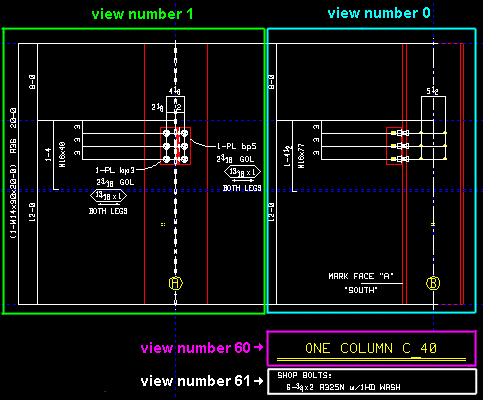
To show a view's number, you can add the X-Y-Z Display to your toolbar. An alternative decoration you can add to display view numbers is the X-Y Dual Show/True Display .

In the Drawing Editor , the X-Y-Z Display shows the view number that the point location target (
) is over.
Troubleshooting: If you Unshorten a drawing then Shorten , only to find that objects are repositioned in a way that seems wrong, the problem might be that the objects are attached to a view that is not the view that they should be attached to. A good troubleshooting method is to select all of the objects that you believe should be attached to the same view, then right-click ( Menu ) and choose " Edit " on the menu . This will open the Multi-Items Edit window. Look at the " Attached to view " field on that window. If that field is gray (shows no view number), then that field has a mixed entry , indicating that objects in your selection have have two or more different view numbers. Entering the desired view number to the " Attached to view " multi-edit field assigns all objects in your selection that one view number.
View number assignment is fairly random. While view numbers assigned during auto detailing are generally the same as the numbers assigned to views in member isolation (or material isolation's edit views mode ), there are cases where that general one-to-one correspondence will not hold. Also, while the main view of a member detail is almost always view 0, the other views are assigned numbers as they are added, and since the order in which views are added is arbitrary, there is little correspondence between a view's number and its type.
How can objects be assigned wrong view numbers? When a user adds an object to a drawing on which there are multiple views (a member detail or a submaterial detail), it is the responsibility of that user to ensure that the object is attached to the correct view. That sounds like an easy thing to do, but it isn't always so simple. Take, for example, a pointer . When a user adds a pointer using Objects > Pointers > Add , the user does not see the Pointer Edit window and therefore does not see the " Attached to view " entry field. Pointers can also be added using Paste , Paste at Original Location , Paste Repeatedly , Paste Special , Paste to Several , Add Standard Detail , Add Standard Detail to Several , Add Weld Combo , Hole Sym Combo , Label Combo , etc. Each of these tools is a different way for users to add a pointer to a wrong view.
Layer: The drawing layer that the pointer you are editing will be drawn on after you press " OK " to close this window. If that layer happens to be hidden (not marked " Show "), the pointer disappears after the first Redraw .
![]()
page 1 | contents | objects > pointers > | objects -- pointers | top
For when you edit one pointer and multiple pointers are in the drawing :
Pointer _ of __ ( not applicable to multi-edit ): The number of the pointer you are editing and the total number of pointers in your current drawing. You can use the VCR buttons to select a different pointer and edit that pointer's settings using this window. When a pointer on a shown layer is selected, it is displayed in green (cyan if its actual color is green). The selected pointer must be on a shown layer for it to be shown.
|
|
| VCR buttons (first-previous-next-last) for selecting a pointer to edit. |
Note: If you change one pointer, then select a different pointer number, the first pointer remains changed even if you press " Cancel " on this window.
page 1 | contents | objects > pointers > | objects -- pointers | top
To close the window :
"OK" (or the Enter key) closes this window and completes the Pointer Edit or Pointer Edit All operation.
Defaults: When you press " OK ," the settings on this window -- except mixed entries -- become the default settings for the next pointer you Add during this session of the Drawing Editor . Even if all you do is double-click a pointer and press " OK " without making any changes on this window, this window's settings become the defaults for the next-added pointer.
"Cancel" (or the Esc key or the ![]() button) closes this window without saving changes you have made. In the case where you selected one pointer for editing but changed more than one pointer, " Cancel " only applies to the pointer that is currently selected as the " Pointer _ of __ ."
button) closes this window without saving changes you have made. In the case where you selected one pointer for editing but changed more than one pointer, " Cancel " only applies to the pointer that is currently selected as the " Pointer _ of __ ."
Defaults: The settings on this window do not become the defaults for new pointers if you press " Cancel " to close this window (unless you used " Pointer _ of __ ").
Tip 1: If you used " Pointer _ of __ " to edit more than one pointer, then Undo (after you have closed this window) does undo all changes made using this window.
Tip 2: Press " Cancel " if you double-clicked a pointer just to review it and don't want to set the defaults for to-be-added pointers.
page 1 | contents | objects > pointers > | objects -- pointers | top
